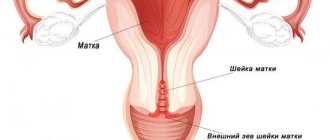The cervix is the lower part of the uterus. In the central part of the cervix there is a narrow canal, on one side of which there is the vagina, and on the other, the uterine cavity. The length of this segment is 3-4 cm, and the cervical canal is normally closed. By appearance and by the way the cervix is located, you can determine what stage of the menstrual cycle a woman is going through at the time of examination, whether she is pregnant, ovulating, and how quickly her period will come.
Also, by the condition of the cervix, you can find out about existing gynecological diseases and developmental disorders. The most commonly diagnosed pathologies of the cervix are endometriosis and cancerous tumors. In order to promptly identify pathologies, it is recommended to examine the organ before ovulation and on the eve of menstruation.
In this article, you will learn what the cervix should be like before menstruation, how an independent examination of the organ is carried out, and what recommendations the doctor gives in this regard.
How does the uterus change?
Every woman needs to know how the uterus changes before the onset of menstruation. Women's cycles affect the condition of the uterine cervix. The organ itself undergoes certain changes right before the critical days and this is quite normal. However, in order to determine such transformations that are provoked by menstruation and the ovulatory period, sometimes you should independently check the vaginal area by touch. If these measures are not suitable for one reason or another, you can visit your gynecologist.
Many people are interested in whether the uterus enlarges before menstruation.
Conditions of the cervix
The cervix is located at the bottom of the uterus and is a tube that connects the reproductive organ to the vagina. It usually reaches 3-4 cm in length.
The cervix is a mirror of a woman's reproductive state. By its changes, you can determine the conception of a child in the earliest stages, ovulation and even approaching menstruation. The gynecologist makes such conclusions based on the position of the cervix and its density. The density of the neck is soft and hard.
It is necessary to monitor the condition of this organ, because this way you can identify pathologies of the woman’s reproductive system. But if for some reason it is not possible to be observed by a specialist, you can examine the uterus yourself. Such manipulations must be carried out with great care and hygiene.
Normal or not?
In healthy women, it is usually hard before menstruation. Enlargement is also quite natural and normal. During this period, the internal mucous membrane lining the organ begins to thicken. In addition, hormonal levels change, swelling appears due to fluid retention - because of this, the weight of the organ can increase.
On the eve of your period, the uterus may drop slightly, and with the onset of ovulation, it begins to open as it prepares for conception.
If fertilization has occurred, the uterus rises and the cervix becomes more moist. Such signs help determine pregnancy at the earliest stages of its development.
During the period of critical days, the cervical pharynx expands slightly, which is provided by nature for faster and unimpeded disposal of blood and exfoliated endometrium. That is why experts do not recommend that women have sexual intercourse during this period, since this position of the organ makes it more likely to get an infection.
What happens to the uterus
All hormonal changes during a cycle in a woman’s body have a direct impact on the state of the organs of her reproductive system. Next, we will look at what happens to the structure and appearance of the cervix at different periods of the menstrual cycle.
Before menstruation
In normal condition, the cervix should be firm and dry. During the period of ovulation, when a mature egg leaves the ovary, the surface of the organ becomes looser, and the pharynx opens slightly, preparing for conception. If the sperm does not reach its final goal or there is no sexual intercourse at all, fertilization does not occur and menstruation begins.
Shortly before the regulus, the uterus begins to descend, so the cervix is low. During the release of the egg and during pregnancy, the cervix becomes softer and moist, and the pharynx begins to open slightly. Thus, the appearance and structure of the organ before the critical days and in the early stages of pregnancy are completely different. Another symptom of pregnancy is the bluish color of the uterus, this color is given to it by blood vessels, the number of which increases significantly after conception.
A woman cannot visually evaluate external changes in the uterine cervix with her own eyes, but she can easily palpate with her fingers, although doctors do not approve of such amateur activity. Shortly before the regula, the uterus should descend, at this time it can be clearly felt, the pharynx should be closed. In the middle of the cycle, the cervix can be felt as a small tubercle with a depression in the middle; before menstruation, this depression narrows.
Let us list the main features that distinguish the cervix before menstruation to the touch and visually:
- its structure should be loose, soft and slightly swollen;
- located at the bottom;
- the external pharynx opens and the canal expands;
- cervical fluid is released slightly;
- the secreted secretion is thick and sticky.
During
We have already found out what the cervix looks like before menstruation, now we will find out what the features of this organ are directly at the time of monthly discharge. During menstruation, the size of the pharynx increases slightly, but unlike ovulation, when its expansion is associated with the body’s preparation for conception, during regulation the pharynx expands to make it easier to push out menstrual discharge and endometrial clots.
Due to the slightly opened pharynx during regulation, the likelihood of infection increases, and the liquid bloody environment becomes an excellent breeding ground for pathogenic microflora. For this reason, during the regulation, swimming in open water, visiting the pool, sex without a condom, and inserting foreign objects into the vagina (fingers, speculum) are not recommended. During this period, protective mucus is secreted moderately, but it cannot always protect a woman from infection, so it is not worth the risk.
During menstruation, the following features are characteristic of the cervix:
- tone decreases;
- sinks low;
- The epithelial cells of the vagina are partially exfoliated;
- The uterine canal opens slightly.
It is very important to observe the rules of personal hygiene during the procedure. It is best to take a warm shower at least 2 times a day and after bowel movements. After defecation, it is necessary to wipe the anus from front to back, otherwise the likelihood of infection increases. You cannot carry out hygiene procedures inside the vagina, insert hygiene products into it or douche, because in this case the risk of spreading infection throughout the reproductive system increases.
Some women may experience pain in the lower abdomen during menstrual periods. Usually these are weak aching or spasmodic sensations that can be tolerated or eliminated with conventional antispasmodics. Such pain is provoked by an enlargement of the uterus due to blood flow to the organ and the process of rejection of blood clots. Sometimes pain can be caused by serious diseases and anomalies of organ development, so that a simple illness does not develop into infertility, you should definitely visit a gynecologist as planned.
The presence of pathologies is also indicated by heavy periods with an unpleasant odor, itching and burning in the perineum, as well as an abnormal color of the secreted secretion. If similar symptoms appear during the regulation, you should definitely go to the gynecologist after they are completed and have an ultrasound of the pelvic organs. Vitamin complexes with Omega-3, hormonal medications, including birth control pills, and painkillers will help normalize the cycle. In severe cases, surgery may be necessary.
After critical days
With the completion of regulation in the uterine cavity, the process of restoration of the inner layer and preparation for possible conception begins. Since blood and clots no longer leave the uterus, the pharynx begins to gradually narrow. The tissues of the cervix thicken and become drier, and they remain this way until ovulation, during which they loosen and are moistened with mucus. After the regula, the uterus rises upward, pulling the cervix along with it, and the active growth of the endometrium immediately begins, since it is there that the fertilized egg should be implanted.
Some women are interested in whether the uterus can enlarge after menstruation. Normally, this can only happen in the case of conception, when the fetus is implanted and blood flow to the uterus begins to increase. Pathological causes of an enlarged uterus include infection and neoplasms. It is a myth that it is impossible to get pregnant during menstruation, so when the uterus becomes enlarged after menstruation, conception is first suspected. To confirm this condition, a hCG test and ultrasound of the pelvic organs are prescribed. During the examination, the gynecologist can detect not only pregnancy, but also polyps, erosions or fibroids, which also affect the size of the reproductive organ.
Let's summarize what features are characteristic of the cervix after regula:
- the mucous layer of the canal thickens;
- the neck is firm and elastic and gradually rises;
- the size of the pharynx narrows;
- more mucus begins to be produced, the peak of its production occurs during the period of ovulation, while the discharge has a watery and slippery consistency, which facilitates better passage of sperm through the cervical canal into the uterine cavity.
Only a gynecologist can thoroughly examine the condition of the cervix; no independent examination with fingers can provide information about diseases or developmental anomalies present in a woman’s body, therefore, if you experience any discomfort in the lower abdomen, you should not postpone a visit to the doctor for long. Timely diagnosis and adequate treatment will help improve a woman’s quality of life, and in some cases can save her.
Patterns
If you visit a gynecologist before the expected menstruation or with a slight delay, even an experienced doctor will not be able to say for sure whether the patient is pregnant, since at this stage the uterus during pregnancy and during menstruation is approximately the same size. Although there are certain patterns:
- in women who have given birth, the uterus is always larger than in girls who have not given birth;
- the organ may have an irregular shape and be enlarged with fibroids;
- an increase in the size of the uterus may be due to the development of adenomyosis.
Let's figure out why the uterus enlarges before menstruation?
Failure of the menstrual cycle as a leading symptom of pathology
Understanding how a tumor affects a woman’s periods, we can predict their changes in a woman:
Menstruation becomes prolonged and lasts more than 7 days
It is important to understand that if a woman had only 3 days of discharge before the illness, then prolongation of the bleeding time even to 5-6 days is an alarming symptom; Menstruation becomes heavy: frequent changes of pads or tampons are required (every 2 hours or more often); In the first days of the cycle, menstruation occurs with clots (typical for a combination of fibroids and adenomyosis); Menstruation becomes painful. Often, to relieve unpleasant symptoms, it is necessary to take antispasmodics or analgesics
The pain radiates to the lower back, sacrum, perineum; Spotting appears before menstruation or immediately after it (bleeds after menstruation or there is prolonged spotting several days before the cycle change). This symptom is also more typical for combined gynecological pathology.
One of the symptoms of uterine fibroids can be severe pain in the lower abdomen during menstruation.
The menstrual cycle with fibroids changes in different ways, but almost always in the direction of increasing the duration of menstruation and the amount of bleeding. Scanty menstruation is not typical for fibroids.
The way menstruation occurs with fibroids is influenced by various factors:
- Node localization. Pronounced changes are observed in submucosal fibroids. Subserous nodes on the stalk do not lead to cycle disruption;
- Knot size. The first symptoms occur when the fibroid reaches a diameter of 2-2.5 cm. The larger the volume of the node, the more pronounced the disturbances will be. With a tumor measuring 10-12 weeks of pregnancy, not only bloody discharge is observed, but also signs of compression of the pelvic organs;
- Number of nodes. The more formations there are in the muscular layer of the uterus, the higher the likelihood of a menstrual cycle failure. See also what uterine myomatosis is, how it manifests itself and methods of its treatment.
The likelihood of menstrual cycle disruption increases with a large number of myomatous nodes.
Causes
Before the start of a new menstrual cycle, most women experience premenstrual syndrome. This condition is often accompanied by a variety of pathological manifestations that affect the physical and mental state. In addition, during this period, girls may feel bloating, which indicates not only a disorder of digestive functions, but also an increase in the size of the uterus.
What actually happens to the reproductive organ? Does it increase before menstruation, what causes this manifestation, how many days before the onset of menstruation can the uterus be enlarged?
To what size does the uterus grow before menstruation?
The arrival of a certain phase of the cycle occurs under the influence of hormonal levels on the body. During the premenstrual period, the concentration of the hormone progesterone in the blood increases. At the same time, there is a decrease in the production of serotonin and estrogen.
About the menstrual cycle
The menstrual cycle should be understood as a period of time that lasts approximately a month when complex processes take place in a woman’s body aimed at preparing for conception. The menstrual cycle is characterized by different durations for different representatives of the fair sex. How many days does the menstrual cycle last? On average it is 21-35 days. The cycle begins on the first day of menstruation and ends on the first day of the next menstruation. A deviation of several days is considered normal.
There are certain indicators that characterize a normal menstrual cycle, namely: the regularity and duration of menstruation, the volume of discharge.
An important component of the menstrual cycle is menstruation. This is a spotting that occurs every month from puberty until menopause.
As a rule, girls have their first periods at the age of 11-16 years; within a year, menstruation becomes regular and the cycle normalizes. The last menstruation in women is approximately at the age of 50-52 years, when the production of sex hormones in the female body decreases and menopause occurs.
During pregnancy and breastfeeding, menstruation stops.
The entire menstrual cycle can be divided into several phases. The first phase is characterized by the production of sex hormones necessary for the maturation of the follicle. Afterwards, ovulation begins, occurring approximately in the middle of the cycle. A mature egg emerges from the follicle, and the third phase begins, characterized by changes in the membrane. If fertilization of the egg does not occur (there was no conception), the endometrium of the reproductive organ is rejected and excreted with secretions, and menstruation begins.
Uterus before menstruation - dimensions
A smooth and dense cervix before the start of a new cycle indicates the absence of pathologies - this is the norm. During the period of ovulation, it has a looser structure and increased softness so that sperm can easily penetrate through the cervical canal.
Uterus size parameters include anterior size, length and width. The cervix and endometrial thickness are measured separately and this is done through ultrasound. Measurements of the body of the uterus are made in the sagittal plane, and its width in the transverse position. The accuracy of the sizes depends on how the ultrasound is performed - with the transabdominal method, the indicators may be slightly increased.
It is important to know how many weeks the uterus enlarges before menstruation.
Changes in the organ can be noticeable 1–2 weeks before the start of menstruation.
How to conduct an inspection correctly
Before menstruation, the cervix becomes softer to the touch and does not provide reliable protection against infections, so the examination must be carried out carefully and all safety recommendations must be followed.
To avoid introducing infection into the uterus, you need to cut your legs short, wash your hands (it is better to wear sterile medical gloves) and insert two fingers into the vagina. Before menstruation, when the cervix is slightly lowered and slightly open, with the middle phalanx of the finger you can feel a small tubercle, in the center of which there is a small round hole.
If pregnancy occurs in the last cycle, then on the due date of the start of menstruation, the cervix will be located very high in the vagina. In addition, it will have a very hard and dense consistency and will not let your finger through even a millimeter (that is, the hole is tightly closed and represents a small gap).
Knowing what the cervix should be like before menstruation, you can easily determine its onset, the period of ovulation, and the presence of pregnancy. But you need to know that even an examination will not allow you to draw a final conclusion, since each female body is individual.
Digital values
Digital values usually have a wide range and depend on the following factors:
- cycle day;
- presence of births and their number;
- menopause period.
Based on this, the normal size of the uterus should be considered in each case separately. In women of reproductive age, the uterus before menstruation can reach 46 mm, before sexual activity - 43 mm, and if a woman has had one or more births - up to 60 mm. These indicators are variants of the norm, and if the uterus is enlarged even more, this may indicate the onset of pregnancy or the development of a certain disease in the woman. These include a variety of benign formations, for example, fibroids, as well as such a common female pathology as endometriosis. Therefore, if the uterus has not returned to its normal size after menstruation, you should consult a specialist.
Prevention of the problem
To avoid the development of infectious gynecological diseases during menstruation, it is necessary to carefully monitor compliance with the following rules:
- exclude any sexual contacts;
- take a shower after each bowel movement and change pads;
- stop douching;
- wash only with clean running water without using cosmetics;
- exclude visiting saunas, swimming pools, public beaches.
Ignoring these simple rules can provoke the development of dangerous infectious diseases that require long-term treatment.
Source: womanchoise.ru
Similar articles
- Can a uterine polyp resolve on its own and come out with menstruation? Most women wonder whether a polyp can come out on its own without surgery? Today, of all gynecological diseases, polyps are most often found in women of all ages. In a limited area...
- Why does appetite increase before menstruation? Women always try to monitor their external parameters. A large audience of ladies is interested in what is the main reason for the need for food, especially before menstruation. It is during this process that it is impossible to restrain your...
- Pain under the armpit before menstruation, during menstruation, why the lymph nodes hurt On the eve of the next menstruation, some women note discomfort in the armpit area, which cannot but bother them. Sometimes bilateral painful tingling sensations appear closer to the mammary gland. If the lymph nodes in the armpits hurt before menstruation,...
How many days does it take for the uterus to enlarge before menstruation?
The average woman's cycle lasts from 28 to 34 days. The uterus begins to enlarge, as a rule, in the ovulatory phase, when it prepares to receive a mature egg, that is, approximately on the 14th day. Enlargement of the uterus before menstruation is normal and should not cause any concern to a woman.
The approach of menstruation is indicated by a softened cervix, which also increases in size and opens slightly. But this phenomenon can only be noticed in those women who have given birth to a child. Therefore, upon examination, the doctor can easily determine this fact. When menstruation ends, the cervix gradually begins to close, but in women who have given birth, it sometimes does not close completely. How many days before menstruation the organ enlarges depends on many different factors. However, in healthy women, before the critical days, the uterus not only enlarges, but in any case descends, just as during the period of ovulation the cervical canal expands, opening the pharynx.
Cervix: what does it look like, where is it located, what functions does it perform?
The uterus is an important female reproductive organ. It is where the growth and development of the fetus occurs. Thanks to its special structure, it prevents harmful microorganisms from reaching it and protects the child from external factors and shocks.
The cervix of the reproductive organ is a tube that connects the vagina to the uterus (you can see what it looks like in the photo). Depending on the period of the cycle and the age of the woman, it changes. In women who have not given birth, the cervix is more elastic and has the shape of a cylinder and is located low. After childbirth, it softens and takes on a more rounded shape. The length of the neck reaches 4 cm, width – 2.5 cm.
The cervix consists of the vaginal and supravaginal zones. In its center is the cervical canal with the internal and external pharynx. The internal pharynx is directed towards the cavity of the reproductive organ, the external pharynx is visible from the side of the vagina upon examination.
There is always a special fluid in the cervical canal. It is necessary to protect the uterus from the effects and penetration of pathological microorganisms. During and before menstruation, fluid ensures complete release of blood discharge.
Self-diagnosis
Some women successfully use the self-diagnosis method, which allows one to exclude or determine the occurrence of pregnancy. To do this, the middle finger must be inserted into the vagina, where it should easily rest against the cervix. Before menstruation, it straightens and falls, which is due to the enlargement of the uterus. At the same time, a depression is noticed in it, which is the entrance to the lumen of the cervical canal.
If before menstruation the cervix is hard and difficult to reach for self-diagnosis, this may primarily indicate pregnancy or that menstruation will not come soon (menstrual irregularity). Throughout pregnancy, the uterus is hard and this helps it hold the fetus. It acquires a loose structure only before childbirth.
What does it mean if the uterus has increased in size excessively?
Consequences and methods of treatment
In the absence of timely treatment, the causes of expansion of the uterine cavity can cause complications. Serious consequences of this pathology include:
- hysterectomy – removal of an organ;
- miscarriages;
- infertility;
- infectious processes.
To prevent such complications, you should consult a doctor if you experience any unpleasant symptoms. Treatment is prescribed based on the extent of the pathology and the patient’s age. The choice of therapeutic regimen depends on the reason that caused the enlargement of the organ.
Inflammation of the uterine cavity is treated with antibiotics, the course is supplemented by taking immunomodulators and vitamin complexes. After treatment, magnetic therapy and current therapy are often prescribed, which normalize the uterine blood supply and resume healthy renewal of the mucous membrane.
In case of hormonal imbalance, you should take medications that improve the synthesis of necessary hormones, which restores the menstrual cycle.
General conservative treatment methods include taking the following medicinal products:
- anti-inflammatory drugs with analgesic activity: Ketonal, Ibuprofen;
- combined oral contraceptives containing gestagen, estrogen;
- testosterone derivatives: Norgestrel, etc.
If there is no improvement, they resort to radical methods of therapy: surgery, hysteroscopy, laparoscopy. The latter methods do not injure the muscular structure of the uterus and are gentle options.
Deviations and their reasons
If before menstruation the uterus greatly increases in size and they exceed the permissible limits for the age group and taking into account the woman’s previous births, this indicates that in this case a certain disease of the reproductive system is developing, which must be cured in a timely manner. The most common pathology in this case is endometrial hyperplasia. In this case, the layer of the internal mucous membrane of the organ can be several times thicker than normal, and this condition is caused by hormonal imbalance and the presence of inflammatory processes. With hyperplasia, a uterine polyp may form during menstruation, which is a certain fragment of the endometrium that did not exfoliate during menstruation and did not come out with blood.
Cervix during pregnancy
If conception occurs, the reproductive organ changes noticeably, but even an experienced gynecologist can rarely determine the successful conception of a child in the early stages. During the examination, the doctor notes what structural changes have occurred in the reproductive organ.
In the early stages, the uterus looks almost the same as before the onset of the menstrual period, because all the changes occur inside it, and they are not easy to detect. But after some time, changes are reflected in the external constitution of the cervix.
The doctor is able to determine a hard cervix when the uterus itself remains very soft. Thus, an already established pregnancy may manifest itself in the early stages, but it is impossible to accurately determine when this will happen. The organ changes greatly during pregnancy. Changes:
- size of the reproductive organ;
- its location in the vagina;
- epithelium shade;
- consistency and density;
- form.
If fertilization of the egg has already occurred, then the specialist determines the change in the color of the cervix. The neck becomes blue. The bluish color is due to a sharp increase in blood flow while maintaining insufficient outflow.
During pregnancy, it becomes loose to the touch, but if pregnancy does not occur, it falls under the influence of progesterone immediately after the ovulation period.
When the egg is successfully implanted, the uterus begins to change in size. The reproductive organ greatly increases in volume and in the fourth week reaches the size of a chicken egg. After some time, when the fetus begins to form, the body of the reproductive organ can be felt in the pelvic area without the help of a specialist.
The isthmus of the uterus also softens and acquires a loose structure. In this regard, an experienced doctor reveals the mobility of the cervix during palpation. Due to the individual characteristics of a woman’s body, it is impossible to name a specific time frame for these changes.
The first sign of pregnancy is a soft cervix.
Endometriosis and fibroids
Another reason that the uterus increases in size excessively before menstruation may be endometriosis. Most often, this pathology is observed in women who have given birth and have hormonal problems. With endometriosis, endometrial particles can be found in neighboring tissues and organs, which should not normally be the case, and this is due to the penetration of menstrual blood into the pelvic cavity.
The cause of a strong increase may be fibroids, which is a benign formation in the uterine cavity. Myoma is removed surgically, especially if it is large.
We looked at why the uterus enlarges before menstruation.
Self-diagnosis
There are situations when a woman does not have the opportunity to visit a gynecologist in a timely manner if discomfort occurs in the lower abdomen. In these situations, you should know how to properly conduct an examination on your own, what the cervix may feel like normally and under various pathologies or conditions, as well as what features of the organ may indicate impending changes or the onset of conception.
How to conduct it correctly
Before palpation, it is advisable to trim the nails on the hand; it is enough to do this on the index and middle finger of the right or left hand, depending on whether the woman is right-handed or left-handed. It is recommended to carry out the inspection only with sterile gloves. For diagnosis, you can choose one of the following positions:
- sitting on the toilet or bidet;
- squatting;
- standing with one leg placed on a higher surface (sofa, bed, edge of the bathroom, etc.);
- a position that deals with a woman in a gynecological chair.
Palpation is carried out with two fingers, which are inserted into the vagina until the tubercle is felt. This should be done without sudden movements, so as not to injure the organ. It is very difficult to assess the structure of the cervix on your own without some experience. A beginner in this kind of diagnosis will be helped by the comparison method. At the same time, you can determine the location of the cervix: if the index finger reaches the organ, it means that the uterus is enlarged and menstruation will soon begin, but if the finger only lightly touches the tubercle, then the uterus is contracted, as after a regul.
It should be remembered that immediately before and during menstruation, palpation is prohibited.
Why not recommended
It is not recommended to conduct a self-examination 2-3 days before the procedure. Even in an examination room, doctors prefer to postpone the procedure until after the critical days. This is due to the following reasons:
- from this moment, the cervix gradually opens, and at the same time the risk of infection and the development of inflammatory processes in the ovaries or fallopian tubes increases significantly. This can trigger the occurrence of adhesions, which subsequently lead to infertility;
- even wearing sterile gloves, you can damage the delicate tissue of an organ; normally, such damage heals quickly, but if an infection occurs, the situation can worsen, and minor erosion can ultimately develop into cancer;
- independent palpation examination provides too little information about the pathologies a woman has. In addition to palpating, the doctor can also examine the cervix using a speculum.
Self-assessment of the condition of the cervix is not prohibited, but it is not very informative, so to find out the cause of discomfort, it is better for a woman to seek help from a gynecologist.
Why don’t doctors advise doing a self-examination of the cervix?
Most often, gynecologists do not recommend examining the cervix yourself. This is due to several reasons:
- Due to the slightly open opening, there is an increased risk of pathogenic bacteria entering the uterus, which can cause gynecological diseases, in particular, such as tubal adhesions, inflammation of the ovaries, which can ultimately lead to infertility in a woman.
- The position of the cervix before menstruation changes, and it lowers slightly into the vagina, so with a careless examination, you can easily injure the cervix, thereby causing the development of erosion, which, if there is any infection in the woman’s vagina, will cause a deterioration in the condition and, in some cases, contribute to the appearance of tumors.
- It is impossible to accurately assess the condition of the cervix on your own, since the gynecologist, in addition to his fingers, uses a special mirror for examination, which allows him to accurately determine the condition of the cervix.
- Even the most experienced doctor will never make a conclusion about an existing pregnancy only on the basis of an examination, since it is necessary to take into account other facts and individual characteristics of the body.
The cervix before menstruation only suggests the imminent onset of menstruation or the presence of pregnancy, which is a reason to undergo additional examinations. Most often this is a pregnancy test and a blood test for hCG.









